
Plus d’un siècle après sa première apparition, les scientifiques ont terminé les devoirs d’Einstein sur la relativité restreinte en électromagnétisme.
Des chercheurs de l’Université d’Osaka montrent la contraction relativiste d’un champ électrique généré par des particules chargées en mouvement rapide, comme le prédit la théorie d’Einstein, ce qui pourrait aider à améliorer la recherche en physique des particules et des rayonnements.
Il y a plus d’un siècle, l’un des physiciens modernes les plus célèbres, Albert Einstein, a proposé la théorie révolutionnaire de la relativité restreinte. La plupart de tout ce que nous savons sur l’univers est basé sur cette théorie, cependant, une partie de celle-ci n’a pas encore été prouvée expérimentalement. des savants qui Université d’Osaka L’Institute of Laser Engineering a utilisé pour la première fois des mesures électro-optiques ultrarapides pour visualiser la contraction du champ électrique entourant un faisceau d’électrons se déplaçant à une vitesse proche de la lumière et pour démontrer le processus de génération.
Selon la théorie de la relativité restreinte d’Einstein, il faut utiliser la « transformée de Lorentz » qui combine les coordonnées de l’espace et du temps afin de décrire le mouvement des objets passant devant un observateur à une vitesse proche de la vitesse de la lumière. Il a pu expliquer comment ces transformations ont conduit à des équations auto-cohérentes des champs électriques et magnétiques.
Alors que les divers effets de la relativité ont été maintes fois prouvés avec un très haut degré d’expérimentation[{ » attribute= » »>accuracy, there are still parts of relativity that have yet to be revealed in experiments. Ironically, one of these is the contraction of the electric field, which is represented as a special relativity phenomenon in electromagnetism.

Illustration of the formation process of the planar electric field contraction that accompanies the propagation of a near-light-speed electron beam (shown as an ellipse in the figure). Credit: Masato Ota, Makoto Nakajima
Now, the research team at Osaka University has demonstrated this effect experimentally for the first time. They accomplished this feat by measuring the profile of the Coulomb field in space and time around a high-energy electron beam generated by a linear particle accelerator. Using ultrafast electro-optic sampling, they were able to record the electric field with extremely high temporal resolution.
It has been reported that the Lorentz transformations of time and space as well as those of energy and momentum were demonstrated by time dilation experiments and rest mass energy experiments, respectively. Here, the team looked at a similar relativistic effect called electric-field contraction, which corresponds to the Lorentz transformation of electromagnetic potentials.
“We visualized the contraction of an electric field around an electron beam propagating close to the speed of light,” says Professor Makoto Nakajima, the project leader. In addition, the team observed the process of electric-field contraction right after the electron beam passed through a metal boundary.
When developing the theory of relativity, it is said that Einstein used thought experiments to imagine what it would be like to ride on a wave of light. “There is something poetic about demonstrating the relativistic effect of electric fields more than 100 years after Einstein predicted it,” says Professor Nakajima. “Electric fields were a crucial element in the formation of the theory of relativity in the first place.”
This research, with observations matching closely to Einstein’s predictions of special relativity in electromagnetism, can serve as a platform for measurements of energetic particle beams and other experiments in high-energy physics.
Reference: “Ultrafast visualization of an electric field under the Lorentz transformation” by Masato Ota, Koichi Kan, Soichiro Komada, Youwei Wang, Verdad C. Agulto, Valynn Katrine Mag-usara, Yasunobu Arikawa, Makoto R. Asakawa, Youichi Sakawa, Tatsunosuke Matsui and Makoto Nakajima, 20 October 2022, Nature Physics.
DOI: 10.1038/s41567-022-01767-w
The study was funded by the Japan Society for the Promotion of Science and the NIFS Collaborative Research Program.

« Drogué des réseaux sociaux. Explorateur d’une humilité exaspérante. Nerd du café. Amical résolveur de problèmes. Évangéliste culinaire. Étudiant. »
